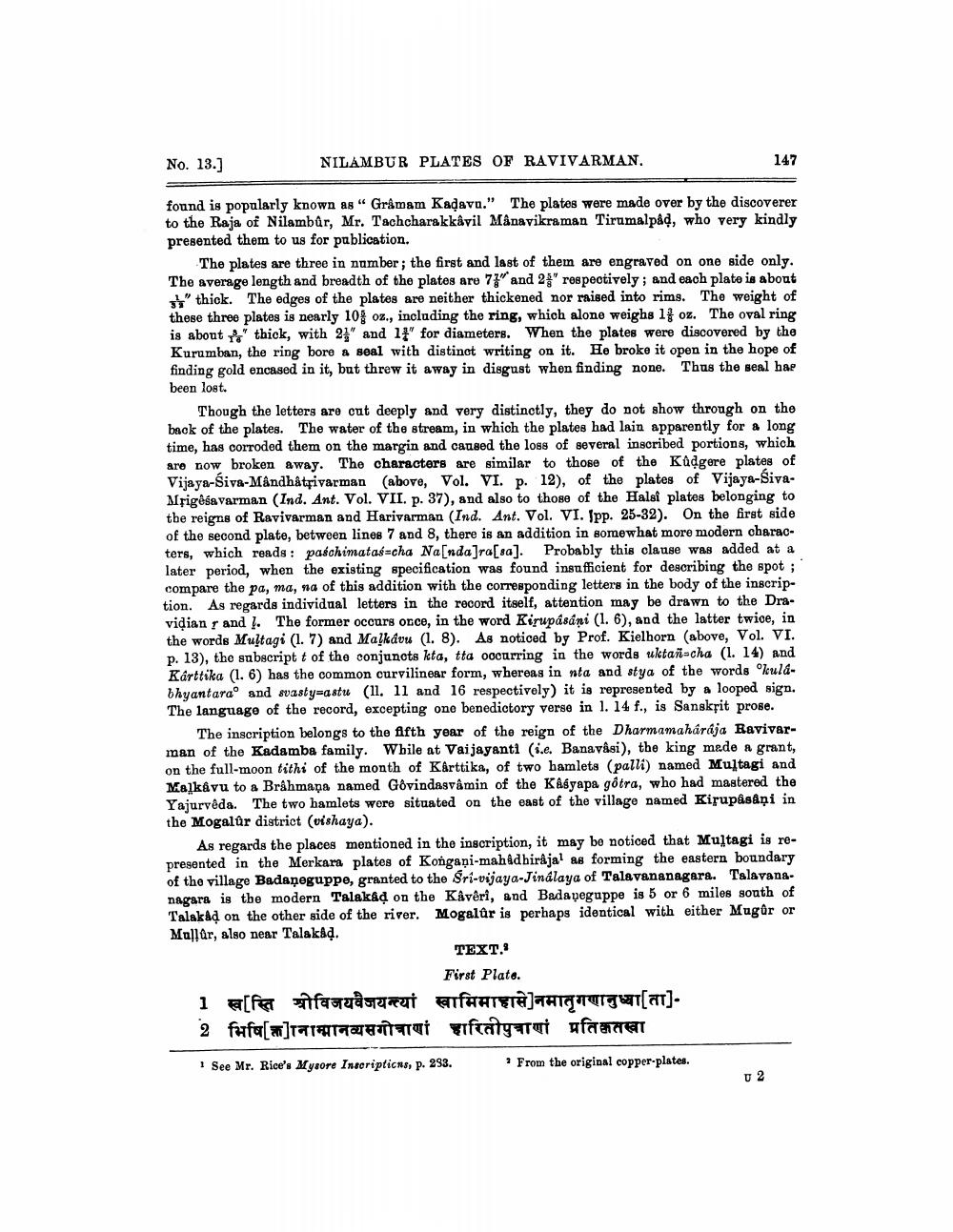________________
No. 13.]
NILAMBUR PLATES OF RAVIVARMAN.
147
found is popularly known as “ Grâmam Kadava." The plates were made over by the discoverer to the Raja of Nilambůr, Mr. Tachcharakkâvil Mânavikraman Tirumalpåd, who very kindly presented them to us for publication,
The plates are three in number; the first and last of them are engraved on one side only. The average length and breadth of the plates are 7" and 28" respectively, and each plate is about
t" thick. The edges of the plates are neither thickened nor raised into rims. The weight of these three plates is nearly 10% oz., including the ring, which alone weighs 1 oz. The oval ring is about it thick, with 2" and 14" for diameters. When the plates were discovered by the Kurumban, the ring bore & seal with distinct writing on it. He broke it open in the hope of finding gold encased in it, but threw it away in disgust when finding none. Thas the seal hae been lost.
Though the letters are cut deeply and very distinctly, they do not show through on the back of the plates. The water of the stream, in which the plates had lain apparently for a long time, has corroded them on the margin and caused the loss of several inscribed portions, which are now broken away. The characters are similar to those of the Kadgere plates of Vijaya-Siva-Mândhâtfivarman (above, Vol. VI. p. 12), of the plates of Vijaya-SivaMrigosa varman (Ind. Ant. Vol. VII. p. 37), and also to those of the Halsi plates belonging to the reigns of Ravivarman and Harivarman (Ind. Ant. Vol. VI. (pp. 25-32). On the first side of the second plate, between lines 7 and 8, there is an addition in somewhat more modern characters, which reads: paschimatas-cha Na[nda]ra[sa]. Probably this clause was added at a later period, when the existing specification was found insufficient for describing the spot ; compare the pa, ma, na of this addition with the corresponding letters in the body of the inscription. As regards individual letters in the record itself, attention may be drawn to the Dravidian r and ļ. The former occurs once, in the word Kirupasáni (1. 6), and the latter twise, in the words Multagi (1. 7) and Malkavu (1. 8). As noticed by Prof. Kielhorn (above, Vol. VI. p. 13), the subscript t of the conjuncts kta, tta occurring in the words uktan-cha (1. 14) and Kárttika (1. 6) has the common curvilinear form, whereas in nta and stya of the words Kuldbhyantarao and svasty=astu (11. 11 and 16 respectively) it is represented by a looped sign. The language of the record, excepting one benedictory verse in l. 14 f., is Sanskrit prose.
The inscription belongs to the Afth year of the reign of the Dharmamaharaja Ravivarman of the Kadamba family. While at Vaijayanti (i.e. Banavâsi), the king made a grant, on the full-moon tiths of the month of Karttika, of two hamlets (palli) named Multagi and Malkavu to a Brâhmana named Gôvindasvâmin of the Kasyapa gôtra, who had mastered the Yajurveda. The two hamlets were situated on the east of the village named Kirupasaņi in the Mogalûr district (vishaya).
As regards the places mentioned in the inscription, it may be noticed that Multagi is represented in the Merkara plates of Kongați-mahdhirajal ag forming the eastern boundary of the village Badaņeguppe, granted to the Sri-vijaya-Jinalaya of Talavananagara. Talavana. nagara is the modern Talakad on the Kêvêri, and Bada veguppe is 5 or 6 miles south of Talakad on the other side of the river. Mogalûr is perhaps identical with either Mugûr or Mullûr, also near Talakad.
TEXT.
First Plato. 1 [fet factuàsteraut HATETE]TTATGTUIGW[at]. 2 भिषिक्तानाम्मानव्यसगोत्राणां हारितीपुत्राणां प्रतिक्कतखा See Mr. Rice's Mysore Inscriptions, p. 293. From the original copper-plates.
U2




